形容词比较级最高级总结
- 格式:doc
- 大小:32.50 KB
- 文档页数:2
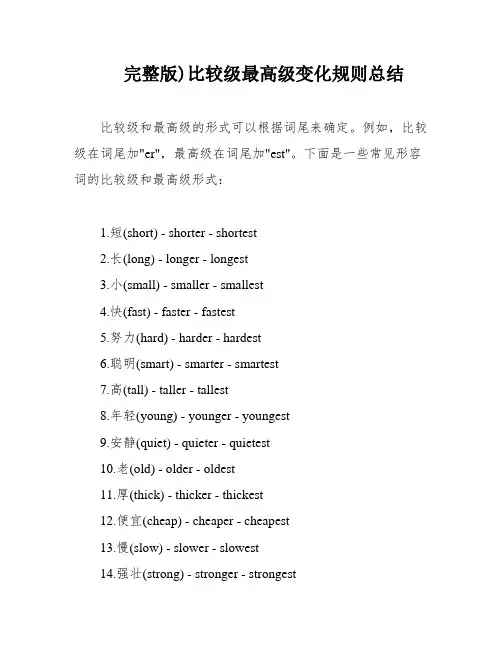
完整版)比较级最高级变化规则总结比较级和最高级的形式可以根据词尾来确定。
例如,比较级在词尾加"er",最高级在词尾加"est"。
下面是一些常见形容词的比较级和最高级形式:1.短(short) - shorter - shortest2.长(long) - longer - longest3.小(small) - smaller - smallest4.快(fast) - faster - fastest5.努力(hard) - harder - hardest6.聪明(smart) - smarter - smartest7.高(tall) - taller - tallest8.年轻(young) - younger - youngest9.安静(quiet) - quieter - quietest10.老(old) - older - oldest11.厚(thick) - thicker - thickest12.便宜(cheap) - cheaper - cheapest13.慢(slow) - slower - slowest14.强壮(strong) - stronger - strongest15.弱(weak) - weaker - weakest16.新(new) - newer - newest17.温暖(warm) - warmer - warmest18.冷(cold) - colder - coldest19.凉爽(cool) - cooler - coolest20.害羞(shy) - shyer - XXX21.紧(tight) - tighter - tightest22.干净(clean) - cleaner - cleanest23.聪明(clever) - cleverer - cleverest对于以不发音"e"结尾的单音节词,比较级直接加"r",最高级直接加"st"。
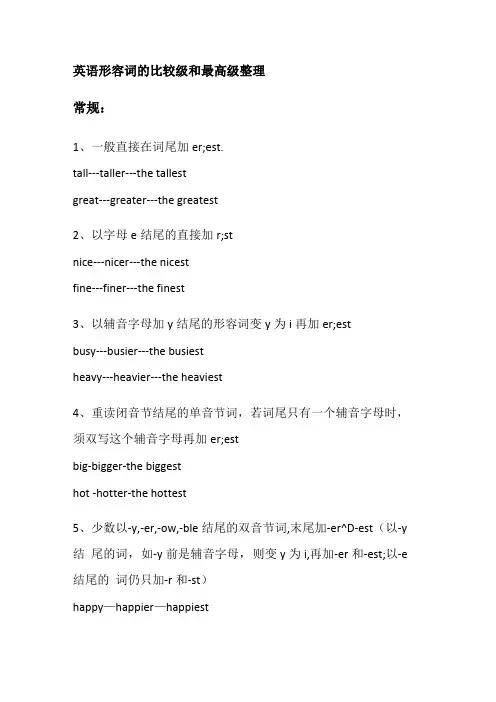
英语形容词的比较级和最高级整理常规:1、一般直接在词尾加er;est.tall---taller---the tallestgreat---greater---the greatest2、以字母e结尾的直接加r;stnice---nicer---the nicestfine---finer---the finest3、以辅音字母加y结尾的形容词变y为i再加er;estbusy---busier---the busiestheavy---heavier---the heaviest4、重读闭音节结尾的单音节词,若词尾只有一个辅音字母时,须双写这个辅音字母再加er;estbig-bigger-the biggesthot -hotter-the hottest5、少数以-y,-er,-ow,-ble结尾的双音节词,末尾加-er^D-est(以-y 结尾的词,如-y前是辅音字母,则变y为i,再加-er和-est;以-e 结尾的词仍只加-r和-st)happy—happier—happiestclever—cleverer—cleverest5、多音节和部分双音节词在词前加more、mosteasily--more easily--most easilybeautiful--more beautiful--the most beautiful特殊:(1 )有些单音节词的比较等级常用more和most,如glad,fond,shy,sly(但like 只可用more 和most)。
Eg:I am not more glad than you.我可没像你那样高兴。
Uncle Jack was more like a book of reference to my father.杰克大叔对我父亲来说真是一部参考书。
(2)有些单音节词用-er和-est或more和most皆可,如free,clear 等。
Eg:I'm clearer/more clear about it than before.对这事,我比以前更清楚了。
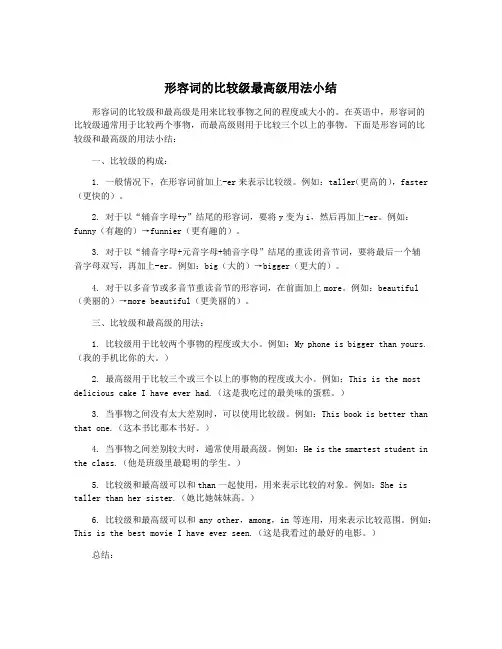
形容词的比较级最高级用法小结形容词的比较级和最高级是用来比较事物之间的程度或大小的。
在英语中,形容词的比较级通常用于比较两个事物,而最高级则用于比较三个以上的事物。
下面是形容词的比较级和最高级的用法小结:一、比较级的构成:1. 一般情况下,在形容词前加上-er来表示比较级。
例如:taller(更高的),faster (更快的)。
2. 对于以“辅音字母+y”结尾的形容词,要将y变为i,然后再加上-er。
例如:funny(有趣的)→funnier(更有趣的)。
3. 对于以“辅音字母+元音字母+辅音字母”结尾的重读闭音节词,要将最后一个辅音字母双写,再加上-er。
例如:big(大的)→bigger(更大的)。
4. 对于以多音节或多音节重读音节的形容词,在前面加上more。
例如:beautiful (美丽的)→more beautiful(更美丽的)。
三、比较级和最高级的用法:1. 比较级用于比较两个事物的程度或大小。
例如:My phone is bigger than yours.(我的手机比你的大。
)2. 最高级用于比较三个或三个以上的事物的程度或大小。
例如:This is the most delicious cake I have ever had.(这是我吃过的最美味的蛋糕。
)3. 当事物之间没有太大差别时,可以使用比较级。
例如:This book is better than that one.(这本书比那本书好。
)4. 当事物之间差别较大时,通常使用最高级。
例如:He is the smartest student in the class.(他是班级里最聪明的学生。
)5. 比较级和最高级可以和than一起使用,用来表示比较的对象。
例如:She istaller than her sister.(她比她妹妹高。
)6. 比较级和最高级可以和any other,among,in等连用,用来表示比较范围。
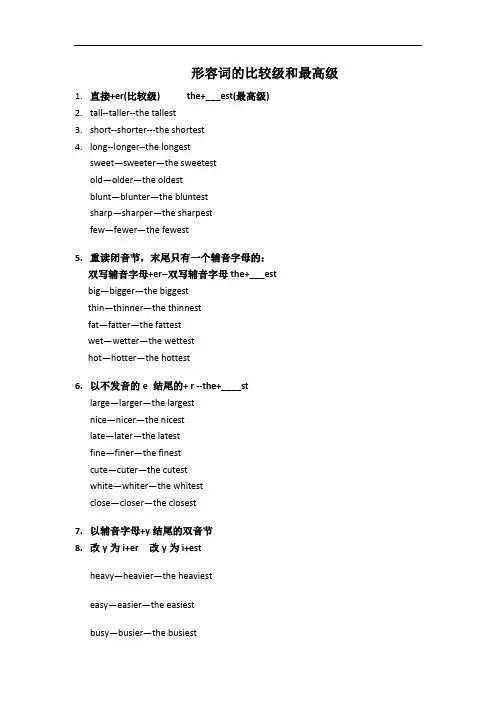
形容词的比较级和最高级1.直接+er(比较级) the+___est(最高级)2.tall--taller--the tallest3.short--shorter---the shortest4.long--longer--the longestsweet—sweeter—the sweetestold—older—the oldestblunt—blunter—the bluntestsharp—sharper—the sharpestfew—fewer—the fewest5.重读闭音节,末尾只有一个辅音字母的:双写辅音字母+er--双写辅音字母the+___estbig—bigger—the biggestthin—thinner—the thinnestfat—fatter—the fattestwet—wetter—the wettesthot—hotter—the hottest6.以不发音的e 结尾的+ r --the+____stlarge—larger—the largestnice—nicer—the nicestlate—later—the latestfine—finer—the finestcute—cuter—the cutestwhite—whiter—the whitestclose—closer—the closest7.以辅音字母+y结尾的双音节8.改y为i+er 改y为i+estheavy—heavier—the heaviesteasy—easier—the easiestbusy—busier—the busiestpretty—prettier—the prettiesthappy—happier—the happiestlazy—lazier—the laziest9.多音节单词在形容词前加more 在形容词前加the mostbeautiful—more beautiful—the most beautifulinteresting—more interesting—the most interestingintelligent—more intelligent—the most intelligentdifficult—more difficult—the most difficultcareful—more careful—the most carefulexciting—more exciting—the most exciting10.不规则变化good—better—the bestbad—worse—the worstmany/much—more—the mostlittle—less—the leastfar(远的)—farther—the farthest句型结构:主语+ be动词+ 形容词的比较级+ than+ 宾语I am taller than Lingling.Jim is fatter than Peter.This dress is prettier than that one. This question is more difficult than that one. This car is better than that one.。
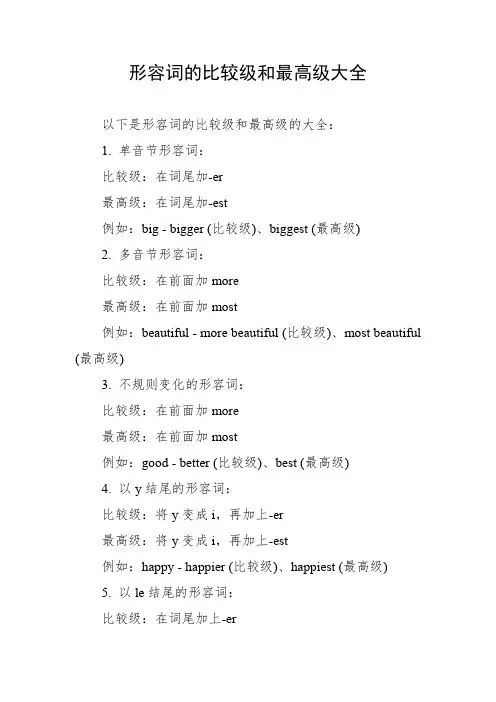
形容词的比较级和最高级大全以下是形容词的比较级和最高级的大全:1. 单音节形容词:比较级:在词尾加-er最高级:在词尾加-est例如:big - bigger (比较级)、biggest (最高级)2. 多音节形容词:比较级:在前面加more最高级:在前面加most例如:beautiful - more beautiful (比较级)、most beautiful (最高级)3. 不规则变化的形容词:比较级:在前面加more最高级:在前面加most例如:good - better (比较级)、best (最高级)4. 以y结尾的形容词:比较级:将y变成i,再加上-er最高级:将y变成i,再加上-est例如:happy - happier (比较级)、happiest (最高级)5. 以le结尾的形容词:比较级:在词尾加上-er最高级:在词尾加上-est例如:possible - more possible (比较级)、most possible (最高级)6. 少数不规则变化的形容词:比较级:在前面加more最高级:在前面加most例如:famous - more famous (比较级)、most famous (最高级)7. 特殊的比较级和最高级:例如:well - better (比较级)、best (最高级)8. 副词的比较级和最高级:比较级:在后面加-er最高级:在后面加-est例如:slowly - more slowly (比较级)、most slowly (最高级)以上是常见的形容词的比较级和最高级,但是也有一些不规则变化的形容词需要记忆。
同时,需要注意的是,有些形容词没有比较级和最高级,如unique。
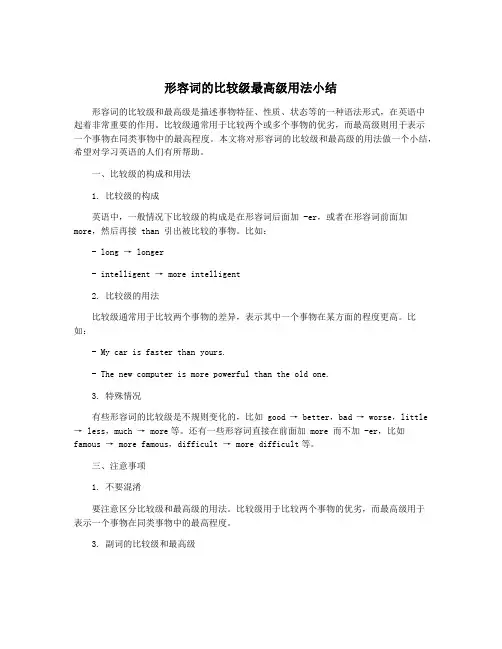
形容词的比较级最高级用法小结形容词的比较级和最高级是描述事物特征、性质、状态等的一种语法形式,在英语中起着非常重要的作用。
比较级通常用于比较两个或多个事物的优劣,而最高级则用于表示一个事物在同类事物中的最高程度。
本文将对形容词的比较级和最高级的用法做一个小结,希望对学习英语的人们有所帮助。
一、比较级的构成和用法1. 比较级的构成英语中,一般情况下比较级的构成是在形容词后面加 -er,或者在形容词前面加more,然后再接 than 引出被比较的事物。
比如:- long → longer- intelligent → more intelligent2. 比较级的用法比较级通常用于比较两个事物的差异,表示其中一个事物在某方面的程度更高。
比如:- My car is faster than yours.- The new computer is more powerful than the old one.3. 特殊情况有些形容词的比较级是不规则变化的,比如good → better,bad → worse,little → less,much → more等。
还有一些形容词直接在前面加 more 而不加 -er,比如famous → more famous,difficult → more difficult等。
三、注意事项1. 不要混淆要注意区分比较级和最高级的用法。
比较级用于比较两个事物的优劣,而最高级用于表示一个事物在同类事物中的最高程度。
3. 副词的比较级和最高级与形容词一样,副词也有比较级和最高级的变化,只是它们的构成方式不同。
一般情况下副词的比较级在其原形后面加上 -er,或者在其原形前面加 more,最高级在其原形前面加上 the most。
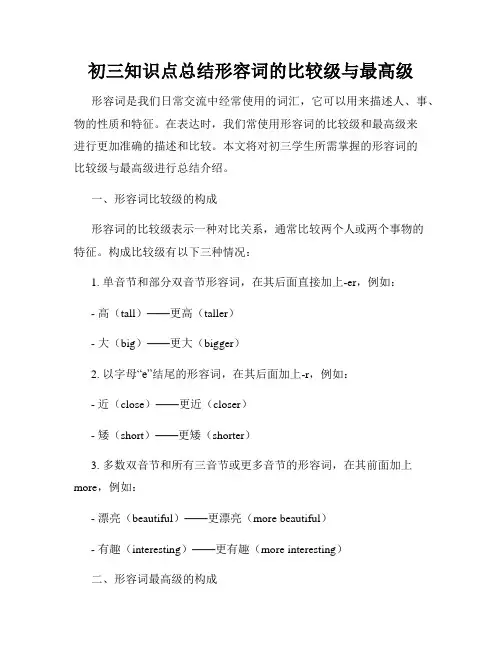
初三知识点总结形容词的比较级与最高级形容词是我们日常交流中经常使用的词汇,它可以用来描述人、事、物的性质和特征。
在表达时,我们常使用形容词的比较级和最高级来进行更加准确的描述和比较。
本文将对初三学生所需掌握的形容词的比较级与最高级进行总结介绍。
一、形容词比较级的构成形容词的比较级表示一种对比关系,通常比较两个人或两个事物的特征。
构成比较级有以下三种情况:1. 单音节和部分双音节形容词,在其后面直接加上-er,例如:- 高(tall)——更高(taller)- 大(big)——更大(bigger)2. 以字母“e”结尾的形容词,在其后面加上-r,例如:- 近(close)——更近(closer)- 矮(short)——更矮(shorter)3. 多数双音节和所有三音节或更多音节的形容词,在其前面加上more,例如:- 漂亮(beautiful)——更漂亮(more beautiful)- 有趣(interesting)——更有趣(more interesting)二、形容词最高级的构成形容词的最高级表示一种最高程度的比较,通常比较三个或三个以上的人或事物的特征。
构成最高级有以下三种情况:1. 单音节和部分双音节形容词,在其后面直接加上-est,例如:- 高(tall)——最高(tallest)- 大(big)——最大(biggest)2. 以字母“e”结尾的形容词,在其后面加上-st,例如:- 近(close)——最近(closest)- 矮(short)——最矮(shortest)3. 多数双音节和所有三音节或更多音节的形容词,在其前面加上the most,例如:- 漂亮(beautiful)——最漂亮(the most beautiful)- 有趣(interesting)——最有趣(the most interesting)三、形容词比较级与最高级的用法1. 当两个人或事物进行比较时,我们使用比较级。
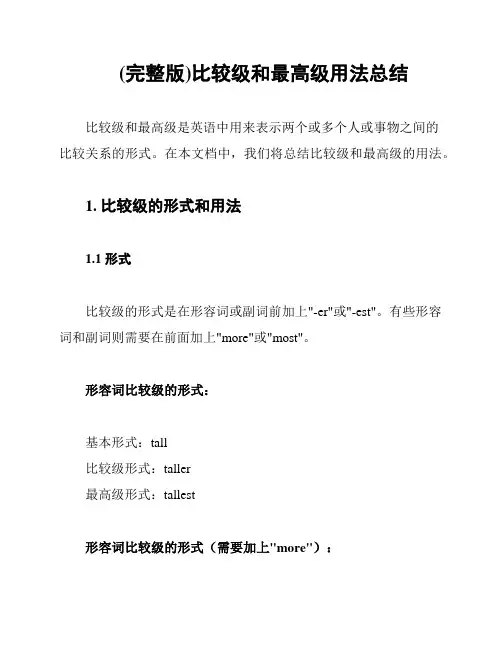
(完整版)比较级和最高级用法总结比较级和最高级是英语中用来表示两个或多个人或事物之间的比较关系的形式。
在本文档中,我们将总结比较级和最高级的用法。
1. 比较级的形式和用法1.1 形式比较级的形式是在形容词或副词前加上"-er"或"-est"。
有些形容词和副词则需要在前面加上"more"或"most"。
形容词比较级的形式:基本形式:tall比较级形式:taller最高级形式:tallest形容词比较级的形式(需要加上"more"):基本形式:beautiful比较级形式:more beautiful最高级形式:most beautiful副词比较级的形式:基本形式:quickly比较级形式:more quickly 或 faster最高级形式:most quickly 或 fastest1.2 用法比较级常用于以下几种情况:- 比较两个人或物体的相对性质或程度。
例如:- He is taller than his brother.- This book is more interesting than that one.- 比较两个人或物体进行选择或决策。
例如:- I prefer coffee to tea.- She is more suitable for the job.- 表示一个人或物体在某一方面比另一个人或物体更具特征。
例如:- The second movie was scarier than the first one.- He is more intelligent than his classmates.2. 最高级的形式和用法2.1 形式最高级的形式是在形容词或副词前加上定冠词"the",并在其后加上"-est"。
有些形容词和副词则需要在前面加上"most"。
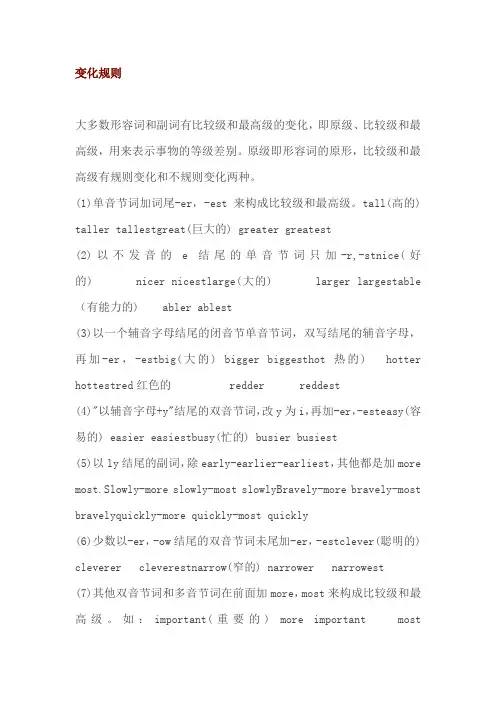
变化规则大多数形容词和副词有比较级和最高级的变化,即原级、比较级和最高级,用来表示事物的等级差别。
原级即形容词的原形,比较级和最高级有规则变化和不规则变化两种。
(1)单音节词加词尾-er,-est来构成比较级和最高级。
tall(高的) taller tallestgreat(巨大的) greater greatest(2)以不发音的e结尾的单音节词只加-r,-stnice(好的) nicer nicestlarge(大的) larger largestable (有能力的) abler ablest(3)以一个辅音字母结尾的闭音节单音节词,双写结尾的辅音字母,再加-er,-estbig(大的) bigger biggesthot热的) hotter hottestred红色的 redder reddest(4)"以辅音字母+y"结尾的双音节词,改y为i,再加-er,-esteasy(容易的) easier easiestbusy(忙的) busier busiest(5)以ly结尾的副词,除early-earlier-earliest,其他都是加more most.Slowly-more slowly-most slowlyBravely-more bravely-most bravelyquickly-more quickly-most quickly(6)少数以-er,-ow结尾的双音节词未尾加-er,-estclever(聪明的) cleverer cleverestnarrow(窄的) narrower narrowest(7)其他双音节词和多音节词在前面加more,most来构成比较级和最高级。
如:important(重要的) more important mostimportanteasily(容易地) more easily most easily(8)一些词的比较级和最高级,可以加-er或 -est,也可以加more 或most如:clever, polite等。
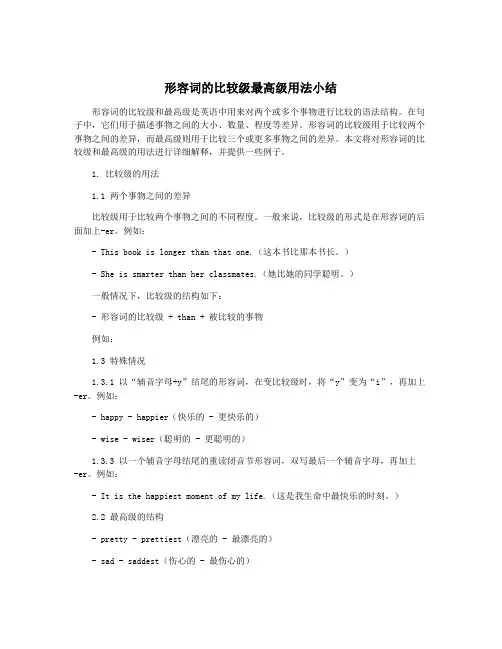
形容词的比较级最高级用法小结形容词的比较级和最高级是英语中用来对两个或多个事物进行比较的语法结构。
在句子中,它们用于描述事物之间的大小、数量、程度等差异。
形容词的比较级用于比较两个事物之间的差异,而最高级则用于比较三个或更多事物之间的差异。
本文将对形容词的比较级和最高级的用法进行详细解释,并提供一些例子。
1. 比较级的用法1.1 两个事物之间的差异比较级用于比较两个事物之间的不同程度。
一般来说,比较级的形式是在形容词的后面加上-er。
例如:- This book is longer than that one.(这本书比那本书长。
)- She is smarter than her classmates.(她比她的同学聪明。
)一般情况下,比较级的结构如下:- 形容词的比较级 + than + 被比较的事物例如:1.3 特殊情况1.3.1 以“辅音字母+y”结尾的形容词,在变比较级时,将“y”变为“i”,再加上-er。
例如:- happy - happier(快乐的 - 更快乐的)- wise - wiser(聪明的 - 更聪明的)1.3.3 以一个辅音字母结尾的重读闭音节形容词,双写最后一个辅音字母,再加上-er。
例如:- It is the happiest moment of my life.(这是我生命中最快乐的时刻。
)2.2 最高级的结构- pretty - prettiest(漂亮的 - 最漂亮的)- sad - saddest(伤心的 - 最伤心的)- 比较级用于比较两个事物之间的差异,最高级用于比较三个或更多事物之间的差异。
- 形容词的最高级的结构是:the + 形容词的最高级 + 名词。
- 在变比较级和最高级时,以“辅音字母+y”结尾的形容词将“y”变为“i”,以“e”结尾的形容词直接加上-r或-st,以一个辅音字母结尾的重读闭音节形容词双写最后一个辅音字母。
- 比较级和最高级在句子中可用于描述事物的大小、数量、程度等差异。
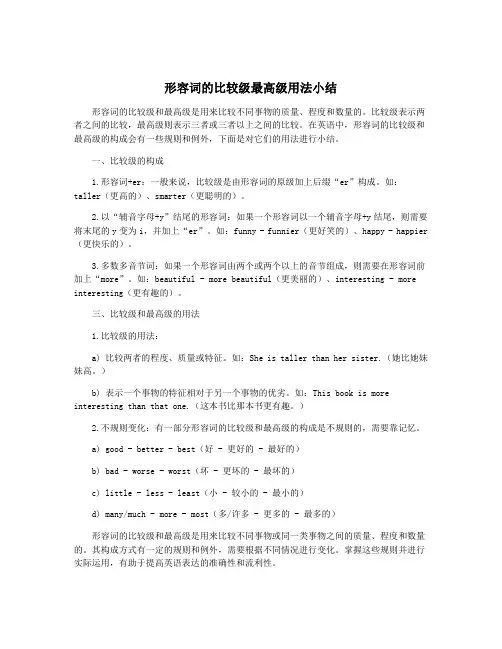
形容词的比较级最高级用法小结形容词的比较级和最高级是用来比较不同事物的质量、程度和数量的。
比较级表示两者之间的比较,最高级则表示三者或三者以上之间的比较。
在英语中,形容词的比较级和最高级的构成会有一些规则和例外,下面是对它们的用法进行小结。
一、比较级的构成1.形容词+er:一般来说,比较级是由形容词的原级加上后缀“er”构成。
如:taller(更高的)、smarter(更聪明的)。
2.以“辅音字母+y”结尾的形容词:如果一个形容词以一个辅音字母+y结尾,则需要将末尾的y变为i,并加上“er”。
如:funny - funnier(更好笑的)、happy - happier (更快乐的)。
3.多数多音节词:如果一个形容词由两个或两个以上的音节组成,则需要在形容词前加上“more”。
如:beautiful - more beautiful(更美丽的)、interesting - more interesting(更有趣的)。
三、比较级和最高级的用法1.比较级的用法:a) 比较两者的程度、质量或特征。
如:She is taller than her sister.(她比她妹妹高。
)b) 表示一个事物的特征相对于另一个事物的优劣。
如:This book is more interesting than that one.(这本书比那本书更有趣。
)2.不规则变化:有一部分形容词的比较级和最高级的构成是不规则的,需要靠记忆。
a) good - better - best(好 - 更好的 - 最好的)b) bad - worse - worst(坏 - 更坏的 - 最坏的)c) little - less - least(小 - 较小的 - 最小的)d) many/much - more - most(多/许多 - 更多的 - 最多的)形容词的比较级和最高级是用来比较不同事物或同一类事物之间的质量、程度和数量的。
形容词的比较级最高级用法小结形容词的比较级和最高级是描述事物特征或性质的一种方式。
比较级是用来比较两个人或物之间的程度、数量或质量的差异。
最高级是用来表示同一类事物中某一人或物在程度、数量或质量上超过其他所有人或物的状态。
形容词的比较级和最高级的用法需要根据不同的情况进行灵活运用。
下面将对形容词的比较级和最高级的用法进行详细的小结。
一、比较级的用法1. 比较两个人或物之间的差异:比较级的形式为“as + 形容词+ as”,表示两个人或物的程度、数量或质量相同。
例如:He is as tall as his father.(他和他的父亲一样高)2. 表示一个人或物在某一方面的极限:最高级的形式为“ever + 形容词最高级”,表示某一方面的极限。
例如:It's the best movie I have ever seen.(这是我看过的最好的电影)三、比较级和最高级的不规则变化1. 某些形容词比较级和最高级的形式与原级有不规则变化。
例如:good(好)- better (更好)- best(最好)2. 某些形容词比较级和最高级的形式与原级保持一致。
例如:early(早)- earlier (更早)- earliest(最早)四、注意事项1. 形容词的比较级和最高级是在形容词的原级的基础上进行形式上的变化,有些形容词的比较级和最高级的形式是不规则的,需要牢记这些不规则的变化。
2. 形容词的比较级和最高级的用法需要根据具体的语境进行灵活运用,尤其是在比较两个人或物的差异时,要根据实际情况选择适当的形式。
3. 在使用形容词的比较级和最高级时,需要注意句子的语法结构和逻辑关系,使句子表达准确、清晰。
通过练习和积累,可以熟练掌握形容词的比较级和最高级的用法。
形容词的比较级和最高级形容词是描述性词语,用于修饰名词或代词,用来表达人、事物或概念的特征和属性。
当我们想要对事物进行比较时,比较级和最高级就派上了用场。
比较级用来比较两个人或物之间的差异,表示“更……”、“比……更……”之意。
形容词的比较级有规律和不规律两种形式。
规律比较级的构成:在形容词后加上“er”。
如:1. 高(tall)- 比较高(taller)2. 富有(rich)- 更富有(richer)3. 长(long)- 更长(longer)当形容词以“e”结尾时,只需在其后加上“r”。
例如:1. 大(large)- 更大(larger)2. 短(short)- 更短(shorter)如果形容词以“辅音字母+元音字母+辅音字母”结尾,且重读最后一个音节时,需双写末尾的辅音字母,并加上“er”。
如:1. 重(heavy)- 更重(heavier)2. 热(hot)- 更热(hotter)不规律比较级则需要变化形态,例如:1. 好(good)- 更好(better)2. 多(many)- 更多(more)3. 少(few、little)- 更少(fewer、less)另外,当比较级前面有“than”时,表示与之前的人或物相比更……。
例如:1. 我比我弟弟更高。
I am taller than my younger brother.2. 这只猫比那只狗更可爱。
This cat is cuter than that dog.最高级用来表示同一类人或事物中最高的一项,表示“最……”或“最高的”。
构成最高级形容词,需要在形容词前加上“the”并在后面加上“est”。
如:1. 高(tall)- 最高的(the tallest)2. 富有(rich)- 最富有的(the richest)3. 长(long)- 最长的(the longest)当形容词以“e”结尾时,只需在其前加上“th”。
例如:1. 大(large)- 最大的(the largest)2. 短(short)- 最短的(the shortest)如果形容词以“辅音字母+元音字母+辅音字母”结尾,且重读最后一个音节时,需双写末尾的辅音字母,并加上“est”。
形容词的比较级和最高级英语中的形容词通常用三种形式来表达事物的等级差别,分别是原级、比较级和最高级。
大部分形容词的比较级和最高级是通过变化词尾来实现的,属于规则变化,但也有少数是不规则变化。
英语中有些形容词说明形状、材质等,还有形容词没有程度可分或其本身就表示某种程度,故而没有比较级和最高级。
常见的有:right 正确的 wrong 错误的 excellent 最好的 final 最后的last 最后的 possible 可能的 first 第一的 east 东方的empty 空的 wooden 木制的 impossible 不可能的 favourite 最喜欢的round 圆的 golden 金色的 square 方的一、比较级和最高级的构成1.规则变化(1)单音节和少数双音节形容词变化规则如下:1)单音节词末尾加-er(比较级),-est(最高级)【例】原级比较级最高级great greater greatestsmall smaller smallestclean cleaner cleanest2)单音节如以e结尾,只加-r(比较级),-st(最高级)【例】fine finer finestnice nicer nicestwide wider widest3)以一个辅音字母结尾的重读闭音节单音节词,须先双写这个辅音字母,再加-er(比较级),-est(最高级)【例】big bigger biggesthot hotter hottestfat fatter fattest4)以“辅音字母+y”结尾的双音节词,将y变为i,加-er(比较级),-est(最高级)【例】happy happier happiesteasy easier easiestheavy heavier heaviestfunny funnier funniest5)以-er,ow,-ble结尾的双音节词,末尾加-er(比较级),-est(最高级)【例】clever cleverer cleverestnarrow narrower narrowestable abler ablest(2)其他双音节词和多音节词在词前加more(比较级),most(最高级)【例】tired more tired most tiredinteresting more interesting most interestingdifficult more difficult most difficult(注意:A:有词根加ly构成的形容词,在词前加more(比较级),most(最高级)如friendly----friend+ly构成, friendly more friendly most friendly;B:以形容前缀un构成的三音节形容词不适合上述情况,如unhappy----unhappier----unhappiest,untidy----untidier----untidiest )2.不规则变化形容词的不规则变化如下:原级比较级最高级good/well better bestbad/ill worse worstlittle/ few less leastmuch/many more mostfar farther更远的(只指距离)further 更远的(指距离);更深入的(指程度)farthest; furthestold older 较老的,较旧的;长辈的(指年龄、新旧、血缘);elder长辈的(只指血缘)oldest; eldest二、比较级的用法(1)高于或低于另一方的比较运用“比较级+than”的结构可以表达一方超过或低于另一方的情况。
形容词比较级和最高级的用法总结大多数形容词和副词有比较级和最高级的变化,即原级、比较级和最高级,用来表示事物的等级差别。
今天店铺在这里为大家介绍形容词比较级和最高级的用法总结,欢迎大家阅读!形容词比较级和最高级的用法篇一1. 规则变化1)单音节词和少数双音节词,加词尾-er,-est来构成比较级和最高级。
构成法原级比较级最高级一般单音节词末尾加-er,-est tall(高的) taller tallest great(巨大的) greater greatest2)以不发音的e结尾和以- le结尾的双音节词只加-r,-st nice(好的) nicer nicest ,able(有能力的) abler ablest3)以一个辅音字母结尾的闭音节单音节词,双写结尾的辅音字母,再加-er,-est big(大的) bigger biggest hot热的) hotter hottest4)"以辅音字母+y"结尾的双音节词改y为i,再加 -er,-esteasy(容易的) easier easiest ,busy(忙的) busier busiest5)少数以-er,-ow 结尾的双音节词末尾加-er,-est clever(聪明的) cleverer cleverest narrow(窄的) narrower narrowest6)其他双音节词和多音节词,在前面加more,most 来构成比较级和最高级important(重要的) more important most important easily(容易的) more easily most easily2. 不规则变化原级比较级最高级good(好的)/ better best well(健康的) bad (坏的)/ worse worst ill(有病的) old (老的) older/elder oldest/eldest much/many(多的) more most little(少的) less least far (远的) farther/further farthest/furthest3.比较级形容词或副词 + than You are taller than I. They lights in your room are as bright as those in mine. 注意:1)要避免重复使用比较级。
形容词和副词比较级和最高级的用法总结1.比较级的构成:形容词/副词的比较级通常在原词后面加上"-er"或者在前面加上"more",如:taller, more beautiful。
不规则变化的比较级词有:good-better, bad-worse, far-further/farther。
2.最高级的构成:形容词/副词的最高级通常在原词后面加上"-est"或者在前面加上"most",如:tallest, most beautiful。
不规则变化的最高级词有:good-best, bad-worst, far-furthest/farthest。
3.比较级和最高级的使用:a.对比两个人或事物时,用于比较它们之间的程度或大小。
例:She is taller than me.(她比我高。
)b.用于句子中表示不同程度的形容词或副词。
例:He runs faster than his brother.(他跑得比他弟弟快。
)c.用于句子中表示同一事物在不同时间或情况下的变化。
例:She is getting more and more beautiful.(她变得越来越漂亮。
)d.用于表示最高程度的形容词或副词。
例:He is the tallest boy in the class.(他是班上最高的男孩。
)4.注意事项:a. 一些形容词和副词的比较级和最高级形式与原形相同,只需要在前面加上"more"或"most"来表示比较级和最高级。
例:brave - braver - bravest , more brave - most braveb.使用比较级时,必须与被比较的人或事物进行比较,不能单独使用。
例:She is taller.(错误)应改为 She is taller than him.(她比他高。
形容词的比较级最高级用法小结比较级是形容词的一种屈折变化形式,表示两个或多个事物之间的比较程度。
最高级则表示三个或以上事物之间的最高程度。
下面是形容词的比较级和最高级的用法小结:一、比较级的用法:1. 基本用法:比较级表示两者之间的比较关系,常用结构为“形容词+er+than”。
例句:She is smarter than her brother.(她比她的哥哥聪明。
)例句:He had more than 10 books.(他有10余本书。
)3. 表示过去的变化:将比较级与动词过去时连用,表示过去某个时刻进行的比较。
例句:It was getting colder and colder last winter.(去年冬天越来越冷。
)4. 表示方向的比较:将比较级与介词“than”连用,表示方向上的比较。
6. 特殊比较级形式:有些比较级的形式与原形不同。
例句:good → better(好→ 更好)7. 不完全比较:在一些情况下,比较级没有与之比较的对象,表示的是一种倾向性、趋势。
8. 比较句型:在比较句型中,比较级常用在主语和系动词的后面,表示主语在某一方面的特点。
2. 基数词最高级:形容词的最高级前面可以加上基数词来表示具体的数目。
3. 广义最高级:有些形容词的最高级在修饰范围上可以具有一定的广义。
4. 最高级的句中用法:在最高级句中,最高级可以置于句首,表达一种强调的语气。
6. 比较级与最高级的比较:比较级表示两者之间的比较关系,而最高级是在三者或多者之间的最高程度比较。
例句:He is taller than his brother, but not the tallest in his class.(他比他的哥哥高,但不是班里最高的。
)以上就是形容词的比较级和最高级的用法小结。
形容词的比较级和最高级可以帮助我们描述事物之间的大小、高低、好坏等比较关系,使语言更加生动形象。
一、形容词、副词的比较级和最高级的构成规则
1.一般单音节词和少数以-er,-ow结尾的双音节词,比较级在后面加-er,最高级在后面加-est;
(1)单音节词
如:small→smaller→smallest short→shorter→shortest
tall→taller→tallest great→greater→greatest
(2)双音节词
如:clever→cleverer→cleverest narrow→narrower→narrowest
2.以不发音e结尾的单音节词,比较在原级后加-r,最高级在原级后加-st;
如:large→larger→largest nice→nicer→nicest able→abler→ablest
3.在重读闭音节(即:辅音+元音+辅音)中,先双写末尾的辅音字母,比较级加-er,最高级加-est;
如:big→bigger→biggest hot→hotter→hottest fat→fatter→fattest
4.以“辅音字母+y”结尾的双音节词, 把y改为i,比较级加-er,最高级加-est;
如:easy→easier→easiest heavy→heavier→heaviest
busy→busier→busiest happy→happier→happiest
5.其他双音节词和多音节词,比较级在前面加more,最高级在前面加most;
如:beautiful→more beautiful→most beautiful
different→more different→most different
easily→more easily→most easily
注意:(1)形容词最高级前通常必须用定冠词the,副词最高级前可不用.
例句:The Sahara is the biggest desert in the world.
(2)形容词most前面没有the,不表示最高级的含义,只表示"非常".
It is a most important problem.
=It is a very important problem.
6.有少数形容词、副词的比较级和最高级是不规则的,必须熟记.
如:good→better→best well→better→best
bad→worse→worst ill→worse→worst
old→older/elder→oldest/eldest
many/much→more→most little→less→least
far →further/farther→ furthest/farthest
二、形容词、副词的比较级和最高级的用法
1.“A + be +形容词比较级+ than + B” 意思为“A比B更……”.
如:This tree is taller than that one. 这棵树比那棵树高.
注意:
①在含有连词than的比较级中,前后的比较对象必须是同一范畴,即同类事物之间的比较.
②在比较级前面使用much,表示程度程度“强得多”.
如:A watermelon is much bigger than an apple.
③very, quite一般只能修饰原级,不能修饰比较级.
2.“比较级+ and + 比较级”或“more and more +原级”表示“越来越……”
如:It becomes warmer and warmer when spring comes.
春天来了,天气变得越来越暖和了.
It is getting cooler and cooler.
天气越来越凉爽.
The wind became more and more heavily.
风变得越来越大.
Our school is becoming more and more beautiful.
我们的学校变得越来越美丽.
3.在含有or的选择疑问句中,如果有两者供选择,前面的形容词要用比较级形式.
如:Who is taller,Tim or Tom? 谁更高,Tim还是Tom?
4. “the +比较级……, the+比较级”,表示“越……越……”.
The more money you make, the more you spend.
钱你赚得越多,花得越多.
The sooner,the better.
越快越好.
5. 表示倍数的比较级用法:
①. A is …times the size /height/length/width of B.
如:The new building is three times the height of the old one.
这座新楼比那座旧楼高三倍.(新楼是旧楼的四倍高)
②. A is …times as big /high/long/wide/large as B.
如:Asia is four times as large as Europe.
亚洲是欧洲的四倍大.(亚洲比欧洲大三倍)
③. A is …times larger /higher/longer/wider tha n B.
如:Our school is twice bigger than yours.
我们学校比你们学校大两倍.
6.形容词、副词的最高级形式主要用来表示三者或三者以上人或事物的比较,表示“最……”的意思.
句子中有表示范围的词或短语.如:of the three, in our class等等.
如:He is the tallest in our class.
他在我们班里是最高的.
7."否定词语+比较级","否定词语+ so… as"结构表示最高级含义.
Nothing is so easy as this.
=Nothing is easier than this.
=This is the easiest thing.
8. 比较级与最高级的转换:
Mike is the most intelligent in his class.
Mike is more intelligent than any other student in his class
7.修饰比较级和最高级的词
1)可修饰比较级的词
①.a bit, a little, rather, much, far, by far, many, a lot, lots, a great deal, any, still, even等.
②. 还可以用表示倍数的词或度量名词作修饰语.
③. 以上词(除by far)外,必须置于比较级形容词或副词的前面.
注意:使用最高级要注意将主语包括在比较范围内.
(错) Tom is the tallest of his three brothers.
(对) Tom is the tallest of the three brothers.
2)下列词可修饰最高级:by far, far, much, mostly, almost.
This hat is nearly / almost the biggest.
注意:
a. very可修饰最高级,但位置与much不同. This is the very best. This is much the best.
b. 序数词通常只修饰最高级. Africa is the second largest continent.
8.要避免重复使用比较级. (错) He is more cleverer than his brother. (对) He is more clever than his brother. (对) He is cleverer than his brother.
9.要避免将主语含在比较对象中.
(错) China is larger that any country in Asia.
(对) China is larger than any other country in Asia.
10.要注意对应句型,遵循前后一致的原则.
The population of Shanghai is larger than that of Beijing.
It is easier to make a plan than to carry it out.
11.要注意冠词的使用,后有名词的时候,前面才有可能有名词.
比较:Which is larger, Canada or Australia?
Which is the larger country, Canada or Australia?
She is taller than her two sisters.
She is the taller of the two sisters.。